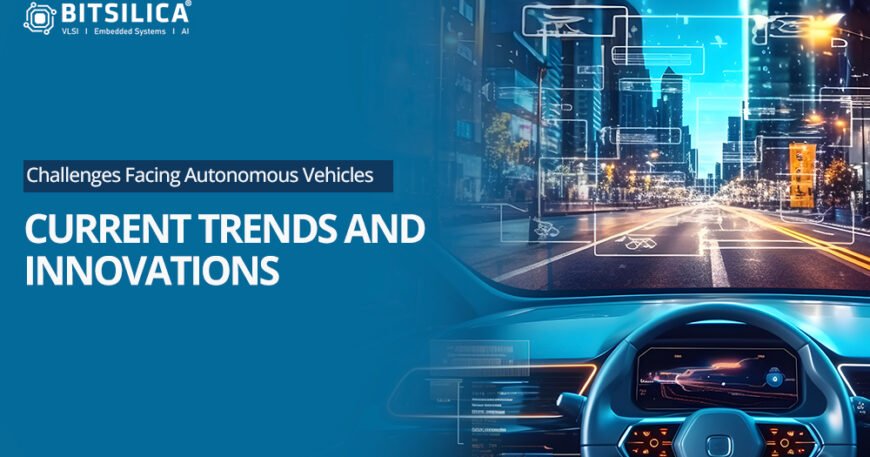Challenges Facing Autonomous Vehicles: Current Trends and Innovations
Autonomous vehicles (AVs) are at the forefront of technological innovation, promising to revolutionize transportation by improving safety, efficiency, and convenience. However, despite significant advancements, several challenges need to be addressed to ensure the widespread adoption and safe operation of AVs. This blog explores the key challenges facing autonomous vehicles and the current trends aimed at overcoming them.
1. AI and Decision Making
Challenge:
Autonomous vehicles rely heavily on artificial intelligence (AI) to make real-time decisions crucial for avoiding accidents and ensuring passenger safety. Errors in AI decision-making can arise from insufficient data, flawed algorithms, or unexpected scenarios the system has not been trained to handle.
Current Trends:
AI algorithms in AVs have made substantial progress, particularly with the adoption of deep learning techniques. These algorithms process vast amounts of data from multiple sensors, enabling precise navigational decisions and hazard prediction. Innovations such as neural networks allow AVs to learn from extensive datasets, improving their decision-making capabilities over time and adapting to new environments. This continuous learning process is essential for enhancing the reliability and safety of autonomous driving systems.
2. Connectivity and Communication
Autonomous vehicles require constant communication with other vehicles, infrastructure, and traffic systems to maintain safety and efficiency. Ensuring secure, high-speed communication channels that operate reliably in various environmental conditions and are resilient to cyber threats is a significant challenge.
Current Trends:
The deployment of 5G technology is a critical development in enhancing vehicle-to-everything (V2X) communications. 5G offers lower latency, higher speeds, and greater reliability, facilitating the rapid exchange of real-time data essential for the operational effectiveness of AVs. This technology supports advanced applications such as platooning, where vehicles travel closely together at high speeds, significantly improving road safety and traffic efficiency.
3. Sensor Technology
Challenge:
Sensors serve as the perceptual organs of autonomous vehicles, providing critical data that informs AI decision-making. These sensors must function accurately and reliably under diverse and often adverse environmental conditions. They need to detect and interpret complex scenarios precisely to avoid errors that could lead to accidents.
Current Trends:
Sensor technology, particularly lidar, has seen significant advancements. Modern lidar sensors offer higher resolution and range capabilities, enhancing the vehicle’s ability to perceive its surroundings in greater detail. The cost and size of these sensors have decreased, making them more accessible and easier to integrate into various vehicle designs. Combining lidar with other sensors like radar and cameras provides comprehensive situational awareness, reducing blind spots and enhancing overall vehicle safety.
4. Regulatory and Safety Standards
Challenge:
Developing a comprehensive legal framework for AV operations is crucial to address potential liabilities in accidents and ensure overall public safety. These frameworks must evolve to keep pace with the rapid advancements in AV technology, ensuring that all operational aspects of autonomous driving are regulated and safe.
Current Trends:
Regulatory bodies worldwide are actively working to create and refine standards and protocols for AV deployment. This includes defining safety requirements, performance criteria, and interoperability standards to ensure that AVs can operate safely within existing transportation ecosystems. These regulations are essential for building public trust and facilitating the integration of AVs into everyday use.
5. Public Perception and Trust
Despite significant technological advancements, public skepticism about AV reliability and safety remains high. Concerns about the technology’s ability to handle complex driving scenarios and respond to emergencies contribute to this mistrust.
Current Trends:
To address these concerns, companies are investing in improving the human-machine interfaces (HMIs) within AVs. By enhancing the intuitiveness and user-friendliness of these interfaces, manufacturers aim to make passengers feel more in control and secure.
Demonstrations, pilot programs, and transparency about system capabilities and limitations are also being used to educate the public and build trust.
These insights into the challenges and current trends highlight the multifaceted approach needed to advance autonomous vehicle technology safely and efficiently. As the industry continues to innovate and adapt, addressing AI and decision-making, connectivity and communication, sensor technology, regulatory and safety standards, and public perception and trust will be crucial focal points for development. The journey towards fully autonomous vehicles is complex, but with ongoing advancements, the promise of a safer and more efficient transportation future is within reach.
Explore More: Driving into the Future: Unveiling the Era of Software-Defined Vehicles





